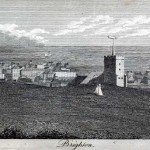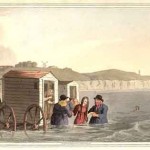 Well, Lydia Bennet wanted to go to Brighton. And by the time Pride & Prejudice was published, Brighton was a thriving seaside resort and, apparently, the location of some highly desirable soldiers – Lydia’s main reason for wanting to go. As we approach the start of summer and those nice, lazy, seaside holidays, let’s take a look at Brighton.
Well, Lydia Bennet wanted to go to Brighton. And by the time Pride & Prejudice was published, Brighton was a thriving seaside resort and, apparently, the location of some highly desirable soldiers – Lydia’s main reason for wanting to go. As we approach the start of summer and those nice, lazy, seaside holidays, let’s take a look at Brighton.
Brighton was originally a fishing village, one of the flourishing ports along England’s south coast. By 1740, however, it was pretty much in decline due to erosion of the town’s beach resulting in loss of buildings, several severe storms, and an ageing population.
Fortunately for Brighton, during the late 18th century sea bathing came into fashion in a big way. The growth in national wealth that resulted in large estates and grand manor houses, also caused urban centers to be more prosperous. People who chose to live in towns had the means to travel outside them. Seaside resorts offered something more than available in the towns or even the countryside.
Spas surrounding mineral springs, such as Bath and Buxton, had been frequented for health reasons from time immemorial. The 18th century saw the advent of seabathing as another healthy activity. The first resorts were located in declining coastal towns such as Brighton, Hasings, Margate, Scarborough, and Weymouth.
Brighton, in particular, benefited from its location in a densely populated region of England and its easy access from London. Moreover, failing economy in the area resulted in a surfeit of accommodation, providing places for visitors to stay.
Brighton was well-established as a seaside resort before the Prince of Wales (later George IV) took a fancy to it in 1783. However, George’s visits and his Royal Pavilion, begun in 1786, certainly increased the draw, first as the place frequented by the Prince of Wales and, later by the Pavilion itself as a tourist attraction.
If you wanted a little seabathing in Brighton during the Regency, you did not have to wait for an invitation from the prince. Brighton had plenty of hotels and guest houses from which to sally forth in your fetching bathing dress and rent a bathing machine for your dip into the channel.
So, do you want to go to Brighton? Or do you have something other than a little seabathing in store for your holidays?




Your post is delightful and brings back fond memories. I took my French friend to Brighton for research. We selected a fine Regency dwelling on the Marine Parade. She wrote a contemporary crime story in which her banker hero lived in the top floor flat of that building with his boyfriend, an antiques dealer. I used the whole house as my 1814 heroine’s summer holiday home in ‘The Rake’s Challenge.’ [Oh, boy, was he challenged.]
The sea may be cold there but the colour of the water is always attractive.
I’d love to go to Brighton. If only to see the Pavillion.
I wouldn’t mind a little sea-bathing this weekend 🙂 Thanks for the delightful post, Myretta! Reminds me of the one time I got to see Brighton…
I’d love to go to Brighton. I might leave off the sea-bathing as what I remember of the waters off British beaches is one word – COLD !! I would love to tour the pavilion and the other buildings of the early nineteenth century!
I would love to go back to Brighton and see the Royal Pavilion. I haven’t been back in years. I do remember going to the beach which was covered in rocks which hurt our feet, no sand anywhere. And yes, the water was freezing!